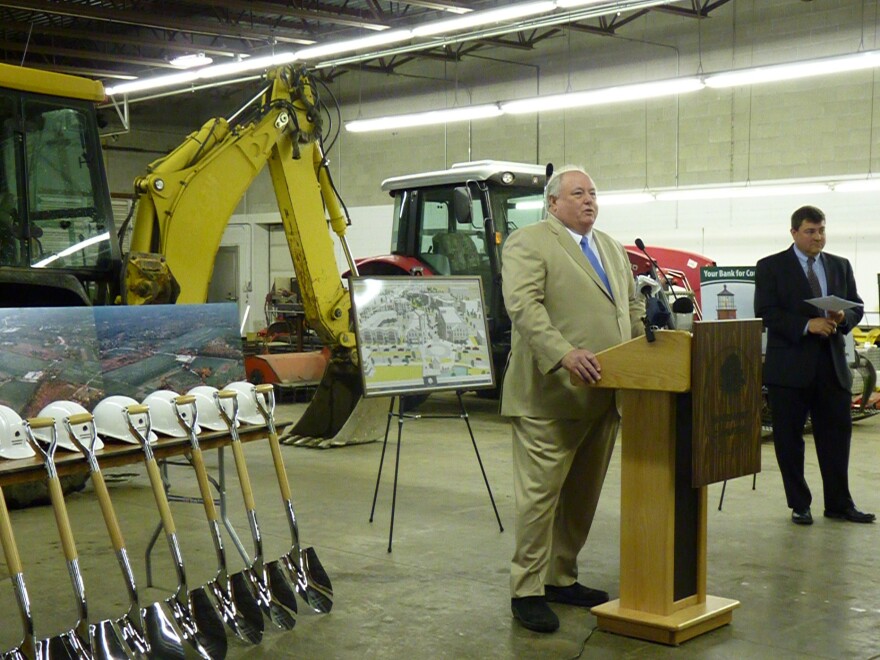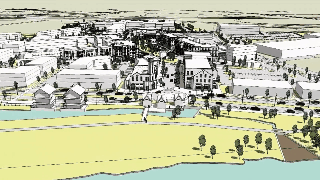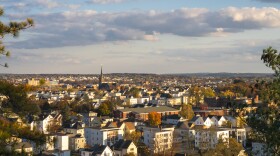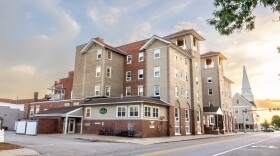Nearly 300 years since its founding, the town of Londonderry is about the get something it’s never had before.
Private developers are looking to reshape a pocket of town with new shops, housing and the promise of walkability: in short, a classic New England Main Street conjured up from scratch.
[This story is the latest in NHPR’s The Balance, a series on the costs, benefits and tradeoffs of living in New Hampshire.]
You have to go back deep into Londonderry’s history to understand why no central hub of commerce ever developed here. When they were first colonized by Scotch-Irish immigrants in 1722, the towns that are now Londonderry and Derry were a single community blessed with decent soil.

“But then when the boundaries split, Derry became that large community, even though it was Londonderry, and Londonderry became the rural farming side of town,” explains Kevin Smith, a longtime resident on the Londonderry side. His town never generated its own downtown following the 1827 divorce.
“That’s one thing that I’ve heard since the time I was kid, to now being Town Manager, is that Londonderry has never had a true downtown center of commerce,” he says.
'The Golden Goose has laid her eggs, and they're right here in Londonderry.'
There were of course shops and trade and capitalism here, but it was always more spread out; nothing like the walkable strip of stores that emerged in Portsmouth, Peterborough or Concord.
Londonderry hasn’t exactly suffered from this void. While it used to be the soil, now it’s the easy access to Interstate 93 that draws in many residents who may commute to Massachusetts. Median household income here is high (above $91,000), and the town’s prodigious apple orchards still give the town a rural charm.
But three centuries after its founding, Londonderry is about to undergo an experiment to bring a Main Street to town.
“The Golden Goose has laid her eggs, and they’re right here in Londonderry,” said an excited Tom Dolan, chair of Londonderry’s Town Council, during a groundbreaking ceremony held last June for Woodmont Commons.
Woodmont Commons is a private development project on a scale never seen before in New Hampshire. The idea is to turn more than 600 acres of land--most of it former apple orchard--into a tidy village, complete with shops, parks, and housing. The project is going to take 20 years to complete.

Pillsbury Realty Development, led by Mike Kettenbach, is spearheading the Woodmont Commons project. Kettenbach’s wife Frances is a part-owner of the Market Basket chain of supermarkets. Legal squabbles between the Kettenbachs and others in the Demoulas family (which is no stranger to legal squabbles) in part delayed construction of a main access road to Woodmont Commons.
That road is now open, however, and to get a better sense of what’s coming, Ari Pollack offered to a tour. Pollack is a lawyer helping to bring this project to life. As he drives around the site, he points out where streets will lead into pedestrian-friendly sidewalks, though all that is still a bit hard to picture because it’s still mostly piles of dirt.
But if the weather cooperates, the first phase of buildings will pop up in 2019. That could include a planned brew pub, performing arts venue, as well as shops and restaurants, with apartments above them.
“We get calls regularly for inquiries for the apartments,” says Pollack. People want to know “how it is going to look, to feel like, what’s it going to smell like?”
Watch the promotional video produced about Woodmont Commons. Via woodmontcommonsnh.com)
While it isn’t emitting a smell just yet, that demand is a good sign, because Woodmont is going to need a lot of it. There are more than 1,400 residential units planned, including townhouses and single family homes. In addition, there are more than 1.5 million square feet of commercial and office space coming to Londonderry. (To put that in perspective, that’s more space than the Prudential Tower in Boston.)
Woodmont is in part modeled on other developments popping up in the south and midwest. These are walkable communities with a decidedly trendy mix of shops and amenities--a modern take on downtown vibrancy.
'You could make lists and lists and lists of thing that could go wrong...A lot can happen to the economy in the next 20 years. The wind could shift.'
From a planning perspective, these communities are a complete reversal from how most development was done during the past half-century: that is, mainly cul de sacs and tract housing.
“That was the American dream. A suburban house on a lot with a picket fence and a lawn to mow,” says Peter Francese, a demographer and close observer of the region’s housing trends.
This new style of construction, he says, is a reaction to shifting consumer demands. Many younger families and young professionals can’t afford the property taxes that come with 2,500 square feet on 2 acres, to say nothing of the time suck of weekly yard work. On the other side of adulthood, empty nesters and Baby Boomers are looking to downsize.

There’s simply not enough housing in Londonderry, or frankly, anywhere in New Hampshire to meet those demands. The state is mired in a housing shortage that’s pushed rental vacancy rates well below normal.
“The rental market is extremely tight,” says Dean Christon, executive director of New Hampshire Housing. “That means there are affordability issues for some. There are choice issues for many people.”
Without an adequate supply of housing, it can be hard to attract and retain workers in the state.
Woodmont is in part a response to that need.
“I love it. I think it is fantastic,” says Francese when asked about the concept of a mixed-use development in New Hampshire. “Now, would I want to see 50 of them? No.”

If too many of these developments pop up, Francese says the state risks losing the rural character that makes New Hampshire a draw.
“The key there is they are not just building housing. They’re building a community,” he adds.
Building community, something authentic--that is no small task. Elizabeth Wood is a town planner, and outgoing state director of the New Hampshire Planners Association. She says anything on this size and scale presents risks.
“You could make lists and lists and lists of thing that could go wrong,” she says. “A lot can happen to the economy in the next 20 years. The wind could shift.”
People’s tastes could change; the pendulum could swing back to white picket fences and suburbia. Another risk is if the architecture and landscaping fall flat, Woodmont could have all the appeal of living in an outlet mall.

To many Londonderry locals, Woodmont inspires a mix of optimism and unease. It might be a great place to spend a Saturday - somewhere to walk around with your in-laws - but it comes at the cost of one of the historic apple orchards that define what Londonderry was and is.
“I will say the one nice thing about having a development like this encased in one small area is that if it is generic and boring and a poor imitation of what it would be like to live in an urban center, then there is still the rest of the town,” says Kirsten Hildonen, who grew up in town and now serves on the board of the Londonderry Historical Society.
“This isn’t going away,” she adds, referring to the town’s history.
It’s true that Londonderry doesn’t need Woodmont to create a community. Hildonen says that’s always been here, even without a true downtown. But she is more than open to the style of housing and quality of life it could bring.
“When the condos go on sale, I’m going to be pretty far up in line to get one.”








